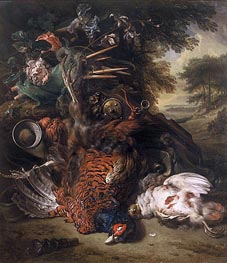
Jan Weenix Giclée Fine Art Prints 3 of 3
1640-1719
Dutch Baroque Painter
Jan Weenix, whose birthdate remains a little blurry somewhere between 1641 and 1649, came of age in an Amsterdam pulsing with creative possibility. His father, Jan Baptist Weenix, was a formidable painter who had spent time in Italy before settling near Utrecht. By the time Jan was twenty, he had already matched - and in many eyes exceeded - his father’s mastery of color and composition. Apprenticed to both his father and his cousin, Melchior d'Hondecoeter, he built a reputation that would one day stretch from Dutch canal houses to grand German palaces.
In 1679, he wed Pieternella Backers, telling the city authorities he was "around thirty." Their home bustled with children and, more than once, stray feathers and furs left behind from his meticulous studio sessions. Weenix’s forte lay in hunting imagery: scenes of pheasants, deer, and other wild creatures, often arranged in surprising balance. Kingly patrons were attracted by his astonishing fidelity to fur and feather, with Johann Wolfgang von Goethe later marveling that Weenix’s animals nearly outdid nature in their lifelike detail.
Some of his most ambitious work adorned private residences. He created a set of five large-scale paintings for Jacob de Granada - each one soon coveted by collectors and eventually scattered across Europe and the United States. Peter the Great himself sat for Weenix in 1697, hoping to capture a bit of Dutch ingenuity on canvas while studying shipbuilding in Amsterdam. Beyond these standout moments, Weenix also contributed a famed cycle of hunting pictures for the Elector Palatine’s castle at Bensberg, sealing his reputation among continental elite.
He lived most of his life near the Mint Tower and remained active in the Utrecht Guild, juggling commissions and raising a flock of children who were baptized in a hidden church. Through it all, his skill never wavered. The trophies he arranged - from a proud peacock in one painting to the slightest ruffled feather of a partridge in another - remind us that he was both a student of his father’s lessons and an independent force in the realm of still life. When he died in 1719, he left behind a body of work cherished by connoisseurs in galleries across Europe, the United States, and beyond. Even centuries later, visitors remain drawn to his naturalistic detail and the deep sense of quiet drama found in the remains of a grand hunt.
In 1679, he wed Pieternella Backers, telling the city authorities he was "around thirty." Their home bustled with children and, more than once, stray feathers and furs left behind from his meticulous studio sessions. Weenix’s forte lay in hunting imagery: scenes of pheasants, deer, and other wild creatures, often arranged in surprising balance. Kingly patrons were attracted by his astonishing fidelity to fur and feather, with Johann Wolfgang von Goethe later marveling that Weenix’s animals nearly outdid nature in their lifelike detail.
Some of his most ambitious work adorned private residences. He created a set of five large-scale paintings for Jacob de Granada - each one soon coveted by collectors and eventually scattered across Europe and the United States. Peter the Great himself sat for Weenix in 1697, hoping to capture a bit of Dutch ingenuity on canvas while studying shipbuilding in Amsterdam. Beyond these standout moments, Weenix also contributed a famed cycle of hunting pictures for the Elector Palatine’s castle at Bensberg, sealing his reputation among continental elite.
He lived most of his life near the Mint Tower and remained active in the Utrecht Guild, juggling commissions and raising a flock of children who were baptized in a hidden church. Through it all, his skill never wavered. The trophies he arranged - from a proud peacock in one painting to the slightest ruffled feather of a partridge in another - remind us that he was both a student of his father’s lessons and an independent force in the realm of still life. When he died in 1719, he left behind a body of work cherished by connoisseurs in galleries across Europe, the United States, and beyond. Even centuries later, visitors remain drawn to his naturalistic detail and the deep sense of quiet drama found in the remains of a grand hunt.
49 Jan Weenix Artworks
Page 3 of 3

Giclée Canvas Print
$72.26
$72.26
SKU: 9625-JWX
Jan Weenix
Original Size:79.2 x 69.5 cm
Mauritshuis Royal Picture Gallery, The Hague, Netherlands
Jan Weenix
Original Size:79.2 x 69.5 cm
Mauritshuis Royal Picture Gallery, The Hague, Netherlands